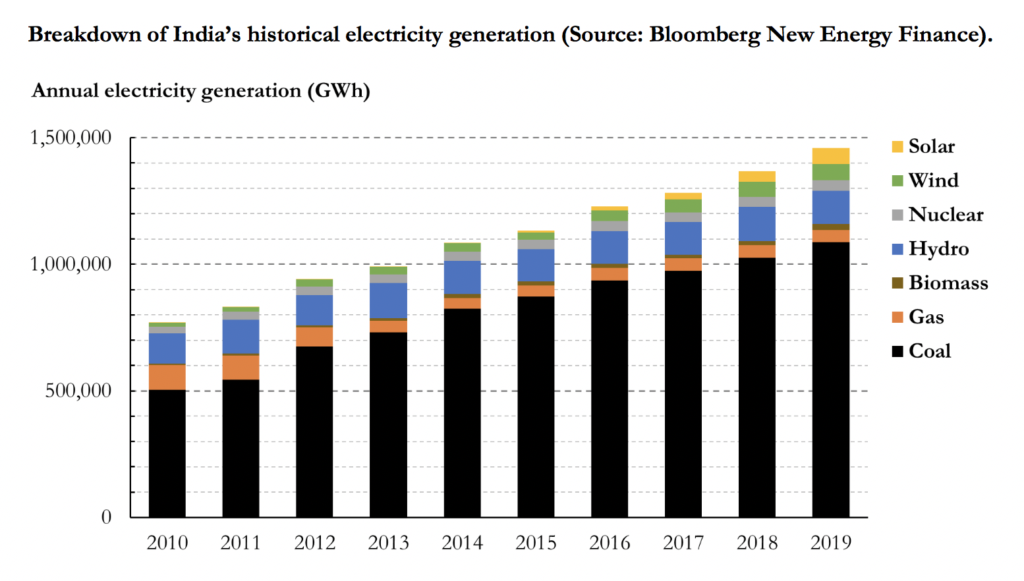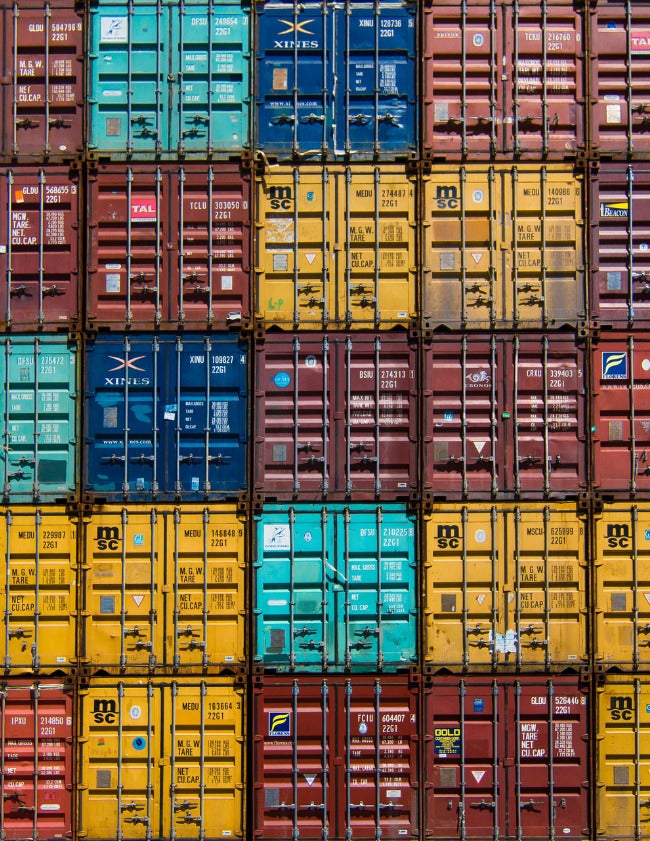In the midst of the coronavirus crisis, 2020 is shaping up as a pivotal year in India’s transition toward renewable energy. Over the prior decade, India dramatically accelerated its deployment of wind and solar power (see figure 1). Now it must grapple with the challenges of integrating ever-larger quantities of volatile renewable energy into its grid. In the first half of 2020, the government has successfully concluded two creative tenders for flexible renewable energy that represent steps in the right direction—even though serious challenges remain to keep India’s energy transition on track.
In January, the publicly-owned Solar Energy Corporation of India (SECI) concluded a tender for 1.2 GW of renewable energy projects with storage that could reliably meet power demand during morning and evening hours. Importantly, the projects will sell their power for a lower price, on average, than that charged by coal power plants. Then in May, SECI concluded another tender for 400MW of “round-the-clock” renewable energy. Those projects will sell renewable energy with an annual capacity factor of 80 percent or more at a price 35 percent less than the average price of coal power. (Note: until March 2020, the author was an executive at ReNew Power, the winner or co-winner of both tenders.)
To be clear, these developments do not mark the swift demise of coal power in India, which provides three-quarters of the country’s electricity. Although coal power generation has fallen in 2020 as the coronavirus depresses demand (renewable generation has continued to grow), India’s demand for power is still likely to bounce back after the crisis and grow sharply in the coming years. As a result, even if renewable energy grows rapidly, it may only meet incremental power demand rather than displacing coal—unlike in the United States, where steady demand means that rising renewable energy will substitute for power from conventional plants. Moreover, these new tender results do not imply that renewable energy systems with storage can perfectly replicate the flexibility of conventional power plants at lower cost. The devil is in the details. For example, the “round-the-clock” tender allows a firm to split a single renewable energy project into several wind and solar farms in faraway states, dramatically overbuild those farms so that they can reliably produce 400 MW of power year-round, and then sell the excess electricity on the market.

Figure 1
But creative new tenders like these represent an evolution of the government’s approach to the energy transition and may make it easier to accelerate additions of renewable energy to avoid the need for more coal power. Over the last decade—the first phase of the renewable energy transition—the Indian government honed its process for competitive auctions to award low-cost contracts to firms to build large-scale wind and solar farms. It succeeded: from 2010 to 2019, India increased its wind and solar capacity six-fold to nearly 80 GW, and costs fell to some of the lowest in the world. To meet its aggressive goals, the government will continue to offer so-called “vanilla tenders” for wind and solar power, which do not require storage or highly-reliable power delivery. By 2030, the government is targeting 450 GW of renewable energy, enabling India to meet half of its power demand with clean sources.
These vanilla tenders do not address many of the challenges that would accompany the unprecedented growth of grid-connected wind and solar capacity targeted by the government. For example, the buyers of renewable energy—state-owned distribution utilities (“discoms”)—struggle to match their power purchases with customer demand. Volatility in renewable energy production, which is tied to weather conditions, can force discoms to buy or sell power on the market at the last minute—an expensive proposition—or face steep penalties for not being able to match supply with demand. By contrast, coal power plants can control the amount of power they produce, making it easier for discoms to purchase just enough power to meet demand.
SECI’s new tenders shift risk away from discoms to the producers of renewable energy. The storage tender in January requires renewable energy producers to guarantee that power will be available during the peak hours in the morning and evening. And the round-the-clock tender this month requires a renewable energy producer to deliver to its discom customers a relatively firm level of power output that averages 320 – 400 MW on an annual basis and 280 – 400 MW on a monthly basis.
Large renewable power producers, such as ReNew Power, are well placed to shoulder this risk. They have access to historical renewable energy production data from across India that helps them forecast future production. They can design and build renewable energy projects that harness geographic diversification, the complementarity of wind and solar power, and a judicious amount of energy storage to deliver a predictable amount of power to discoms. The round-the-clock tender model also adds another risk—and potential reward—for renewable producers to manage: that of selling excess renewable power on the market and hoping to secure a good price. Although discoms are eager to reduce their exposure to markets from trying to match volatile renewable energy with customer demand, power producers that harness forecasting and storage technologies may profit from taking on market risk.
The increasing use of markets is a positive development. India’s electric power sector is highly inefficient today. Discoms and power plants have long-term contracts that lock them into transacting with each other; existing markets for day-ahead and real-time electricity trading are tiny and often illiquid. By contrast, in the United States and many other countries, power is constantly traded on wholesale electricity markets, and a grid operator efficiently schedules and dispatches the fleet of power generators to meet customer demand. Large and efficient markets will be necessary for India to efficiently integrate massive quantities of renewable energy and harness conventional power plants to operate flexibly and compensate for intermittent wind and solar power.
Beyond market reforms, India will need to invest in infrastructure to improve the flexibility of its power system. India’s nationwide grid—the largest in the world—is adequate to transport existing levels of volatile renewable energy. Therefore, under the round-the-clock tender, a firm can inject massive quantities of renewable energy into multiple points on the grid without worrying about the physical capacity of the grid to absorb it.
In the future, this may not be true. Last year, India’s investment in building out its transmission grid was the lowest in six years. India should urgently invest in beefing up the grid to prepare for an influx of new renewable energy capacity over the coming years. Moreover, as the cost of energy storage continues to fall, the government should encourage the deployment of storage in areas of the grid that need it most—rather than only in conjunction with renewable energy projects.
Even deeper—and more politically charged—reforms are critical. In particular, India’s discoms suffer from chronic financial stress and rarely pay for renewable energy on time. Mismanagement and political decisions to provide free or subsidized power to large swathes of the population have hobbled discoms. And the coronavirus crisis has worsened the situation: discom losses are forecast to double this year to $15 billion. Further accelerating the deployment of renewable energy will require reducing the risks that renewable energy firms face, thereby enabling them to raise capital more easily.
The creative tenders in early 2020, therefore, are just the first steps for India to continue its transition to renewable energy. Over the last decade, India’s government had the luxury of focusing mostly on adding solar and wind energy capacity as fast as possible. Now it must walk, chew gum, and much more. The next phase will require deep structural reforms to create a cleaner, more flexible, and more efficient power system. But given the impressive progress to date on deploying renewable energy and the willingness of the government to constantly experiment with new policy approaches, there is reason for optimism about India’s energy future.
Dr. Varun Sivaram is a nonresident senior fellow at the Aspen Institute, a visiting senior fellow at Columbia University, and the former Chief Technology Officer of ReNew Power, India’s largest renewable energy company. Watch a conversation between Dr. Sivaram and Greg Gershuny, executive director of the Institute’s Energy and Environment Program, on the role of innovation in India’s energy transition below.
d


